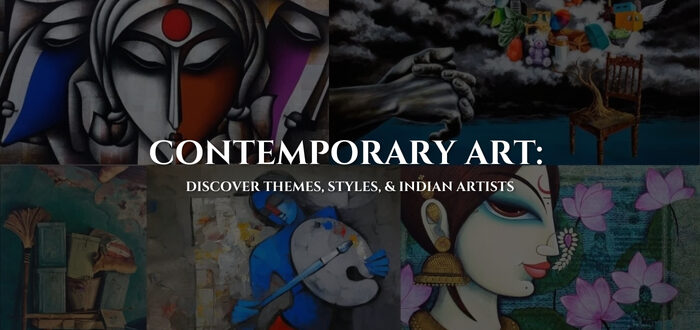Discover Contemporary Art: Themes, Styles, and Indian contemporary artist
What is Contemporary Art?
Contemporary art refers to the art of today, produced by living artists from the mid-20th century to the present. Unlike previous art movements, contemporary art is not bound by rigid structures or specific techniques. Instead, it is characterized by its diversity in form, concept, and expression, embracing a wide range of ideas, mediums, and social issues. Though the exact starting point of this art is still debated; however, many art historians consider the late 1960s or early 1970s to be an adequate estimate.
Many of contemporary art’s guiding principles began long before this, however. One can clearly point to Cubism and its push toward abstraction as one important step for contemporary art. Surrealism and its basis in the unconscious provided another push to new art forms.
Read More about Cubism Here
This blog takes a closer look at the defining characteristics, key themes, and styles of contemporary art, and highlights the influence of Indian artists who are shaping this global artistic landscape.
Characteristics of Contemporary Art:
Contemporary art is defined not only by the era in which it is created—generally from the 1960s to the present—but also by the concepts, mediums, and contexts it addresses. Some of the key characteristics that distinguish contemporary art include:
- Conceptual Approach: In many cases, the idea or concept behind the work is more important than the finished product. Contemporary art often asks questions or invites viewers to think deeply about social, political, or environmental issues.
- Globalization and Cultural Intersections: Artists no longer belong to one fixed national or cultural identity. Globalization has allowed for the blending of cultures, ideas, and practices, leading to art that speaks to a broader, more international audience.
- Social and Political Commentary: Artists like Jitish Kallat focus on socio-political issues, including migration, human rights, and historical trauma. Many contemporary artists do not shy away from addressing controversial topics and often use their art as a form of protest or awareness.
- Diverse Mediums: Artists today use an expansive range of materials, including traditional paint and sculpture, as well as digital media, installations, video art, and even interactive experiences.
- Environmental Awareness: The ecological crisis has become a key concern for many contemporary artists. Artists such as Subodh Gupta have used their work to comment on consumption and waste, while others explore the human impact on nature.
How Contemporary Art Differs from Previous Art Periods
While previous art movements such as Modernism, Postmodernism, and Impressionism focused on specific aesthetics, techniques, or philosophies, contemporary art is broader and more inclusive. Key differences include:
Read More about Impressionism here
Fluidity of Styles: Where past movements had rigid structures or styles—such as Cubism or Surrealism—contemporary art embraces fluidity. There are no strict rules or formulas. Artists are free to combine different techniques and traditions to suit their message.
Focus on Concept over Form: Modern art focused on breaking away from representational art to explore abstract forms. In contrast, contemporary art often prioritizes the message or idea over the aesthetics
Interactive and Participatory: Unlike traditional art, which was often static and meant to be observed from a distance, contemporary art frequently involves interaction.
Global Influence: While past art movements were often centered in the West, contemporary art is truly global. Artists from various countries play pivotal roles in shaping the art world.
Indian Influences in Contemporary Art
Indian contemporary art is a dynamic and diverse reflection of the country’s rich cultural heritage, social changes, and global influence. Over the years, many Indian artists have gained international recognition for their thought-provoking works that challenge traditional norms and explore a wide range of themes, from identity and politics to spirituality and social issues.
Famous Contemporary Artist of India
- Jogen Chowdhury: Master of Figurative Art
Jogen Chowdhury is a key figure in Indian contemporary art, known for his distinct style of figurative art that blends Indian traditional forms with modern themes.
Chowdhury’s works often depict the human figure with an acute sense of distortion and tension, capturing the emotional and psychological complexity of his subjects.
-
Laxma Goud: The Voice of Rural India
Laxma Goud, born in 1940 in Andhra Pradesh, is a prominent figure in Indian contemporary art known for his depictions of rural life, and the intersection of the human and natural world. His art often reflects the lives of villagers, using a variety of mediums including etching, painting, and drawing.
-
Bharti Kher: Exploring Identity and Femininity
Bharti Kher, born in 1969 in London and based in New Delhi, is a contemporary artist known for her use of the bindi, a traditional Indian symbol, as a central motif in her work. Kher’s art explores themes of identity, gender, femininity, and post-colonialism. Kher’s most iconic works feature thousands of bindis arranged in abstract patterns across sculptures or canvases, symbolizing the multiplicity of female identity.
-
M.F. Husain: The Picasso of India
Maqbool Fida Husain, popularly known as M.F. Husain, is one of the most celebrated and controversial figures in Indian contemporary art. He is often referred to as the “Picasso of India” due to his unique style and prolific output. Husain’s paintings, which often depicted Indian mythology, history, and modern life, were bold and vibrant, characterized by fluid lines and dynamic forms.
The Global Influence of Indian Contemporary Artists
Indian contemporary artists have played a pivotal role in shaping not only India’s artistic landscape but also influencing global art. Their work represents a blend of traditional Indian themes and modern-day issues, creating a space for Indian voices in the international art world.
Conclusion: The Evolving Landscape of Contemporary Art
Contemporary art is as fluid and dynamic as the world it mirrors. With its emphasis on conceptual depth, a diverse range of mediums, and a willingness to confront pressing social, political, and environmental issues, contemporary art continues to evolve.
Indian contemporary artists, in particular, have played a pivotal role in shaping this global art scene, drawing from both their cultural heritage and the modern world to create compelling, thought-provoking works. As the world changes, so too does contemporary art, ensuring its ongoing relevance and ability to inspire new ways of thinking.
🎨Modern & Contemporary Art at GIFTEX Auction! 🎨
Step into the world of extraordinary art at the Giftex Upcoming Modern & Contemporary Art Auction, where iconic masterpieces and fresh talent come together under one roof! This is your chance to own a piece of art history featuring works by legendary artists like Thota Vaikuntam, M F Hussain, F N Souza, and many more emerging stars.
Giftex, one of the most popular auction houses is proud to announce its Modern & Contemporary Art Auction on 14-15 October 2024
Don’t miss this exclusive opportunity to bid on breathtaking art and elevate your collection!
Turn your walls into a masterpiece with GIFTEX—where art comes to life!






